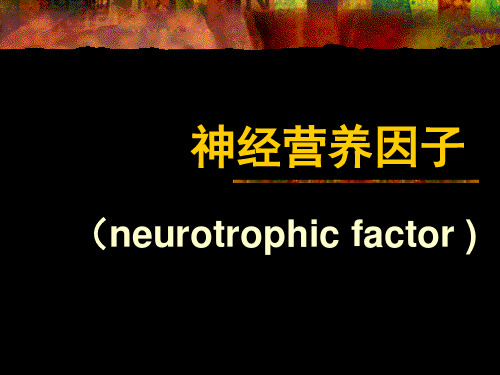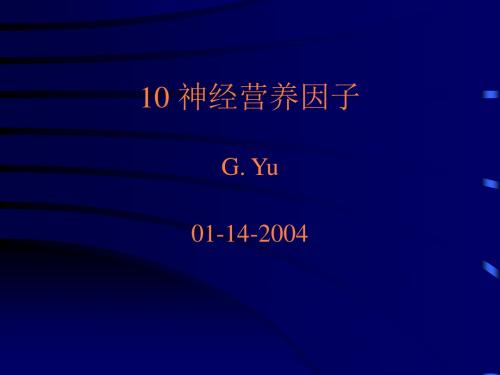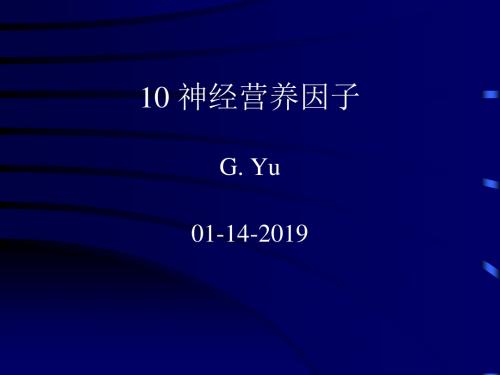神经生物学课件神经营养因子
合集下载
神经营养因子

学术文献
1、神经营养因子是指机体产生的能够促进神经细胞存活、生长、分化的一类蛋白质因子.过去一直认为神经 生长因子主要在发育过程中调节神经元存活,而对成年神经元不产生作用。
2、一般将神经营养物质和上述对神经细胞存活具有调节作用的生长因子统称为神经营养因子.2 神经营养 因子概述21 神经营养物质的结构及其受体神经营养物质如NGF、BDNF、NT3、NT45及NT6等。
神经营养因子
由神经所支配的组织和星形胶质细胞产 生的且为神经元生长与存活所必需的蛋
白质分子
目录
01 介绍
03 分类和作用
02 发现过程 04 受体
目录
05 其他影响作用
07 研究成果
06 学术文献
神经营养因子 ( neurotrophin, NT )是一类由神经所支配的组织(如肌肉)和星形胶质细胞产生的且为 神经元生长与存活所必需的蛋白质分子。神经营养因子通常在神经末梢以受体介导式入胞的方式进入神经末梢, 再经逆向轴浆运输抵达胞体,促进胞体合成有关的蛋白质,从而发挥其支持神经元生长、发育和功能完整性的作 用。近年来,也发现有些 NT由神经元产生,经顺向轴浆运输到达神经末梢,对突触后神经元的形态和功能完整 性起支持作用。
感谢观看
受体
已发现神经末梢上有高亲和力和低亲和力两类 NT受体,高亲和力受体是一类为 140 kD的结合酪氨酸激酶的 受体,包括 trk A、 trk B和 trk C受体三种。 Trk A受体对 NGF的亲和力较高; trk B受体对 BDNF和 NT4/5的亲和力较高;而 Trk C受体则主要与 NT-3结合。各种受体均以二聚体的形式存在,受体激动后可促发胞浆 内酪氨酸蛋白激酶的磷酸化。低亲和力受体是一种 75 kD的膜蛋白,称为 p75 NTR。这种受体的数量远比高亲和 力受体多,约为后者的 7倍。 P75 NTR与 Trk A单体形成的二杂合体能增强与 NGF特异结合的亲和力。但由两 个 p75 NTR聚合而成的同源二聚体与 NT结合时,则可引起相反的效应,甚至导致细胞凋亡。
最新发育神经生物学基础(神经损伤和神经营养物质)(ppt x页课件ppt

发育神经生物学基础(神经损伤 和神经营养物质)(PPT X页)
一、中枢神经的损伤、修复与再生
传统认为,只有周围神经系统损伤后能够再生,中 枢神经系统损伤后不能再生。现发现中枢神经在合适条 件下能够再生。
1928年,Cajal断言:CNS一旦发育完成,神经元损伤 后不能再生。 1958年,Liu &Chambers的实验,证明了成年哺乳动 物的CNS具有较大的可塑性,可以再生。
NEUROSCIENCE
二、周围神经的损伤、修复与再生
NEUROSCIENCE
㈠ 神经元对损伤的反应
o 远侧段神经纤维的顺行性溃变(Waller溃变) o 近侧段神经纤维的逆行性溃变(间接Waller溃变) o 细胞体的变化——轴突反应 o 跨神经元溃变
Waller溃变:
轴突的变化:先是线粒体的局部堆积,随之细胞器发生 颗粒性分解,后来轴突肿胀、断裂、溶解,最后被吸收。
NEUROSCIENCE
1、 影响中枢神经再生的主要因素
(1)胶质瘢痕(glial scar):CNS损伤后,受损神经纤 维发生溃变,星形胶质细胞反应性增生,当清除溃变产物 后,以其突起充填遗留的空隙,形成致密的glial scar。
尽管反应性胶质细胞能释放NGF,刺激神经元的生长 和再生,但glial scar构成的屏障阻止轴突的生长,使再生 流产。
再生的机制: 1、雪旺细胞增殖,形成Bungner带
雪旺细胞的作用:吞噬溃变的轴突和髓鞘,合成和分泌多 种NTF,合成和分泌ECM。
2、轴突的芽生
NEUROSCIENCE
NEUROSCIENCE
第三节 神经营养物质
NEUROSCIENCE
NTF
NGF的发现者Levi-Montalcini、Cohen获1986年诺贝尔生理学奖 NEUROSCIENCE
一、中枢神经的损伤、修复与再生
传统认为,只有周围神经系统损伤后能够再生,中 枢神经系统损伤后不能再生。现发现中枢神经在合适条 件下能够再生。
1928年,Cajal断言:CNS一旦发育完成,神经元损伤 后不能再生。 1958年,Liu &Chambers的实验,证明了成年哺乳动 物的CNS具有较大的可塑性,可以再生。
NEUROSCIENCE
二、周围神经的损伤、修复与再生
NEUROSCIENCE
㈠ 神经元对损伤的反应
o 远侧段神经纤维的顺行性溃变(Waller溃变) o 近侧段神经纤维的逆行性溃变(间接Waller溃变) o 细胞体的变化——轴突反应 o 跨神经元溃变
Waller溃变:
轴突的变化:先是线粒体的局部堆积,随之细胞器发生 颗粒性分解,后来轴突肿胀、断裂、溶解,最后被吸收。
NEUROSCIENCE
1、 影响中枢神经再生的主要因素
(1)胶质瘢痕(glial scar):CNS损伤后,受损神经纤 维发生溃变,星形胶质细胞反应性增生,当清除溃变产物 后,以其突起充填遗留的空隙,形成致密的glial scar。
尽管反应性胶质细胞能释放NGF,刺激神经元的生长 和再生,但glial scar构成的屏障阻止轴突的生长,使再生 流产。
再生的机制: 1、雪旺细胞增殖,形成Bungner带
雪旺细胞的作用:吞噬溃变的轴突和髓鞘,合成和分泌多 种NTF,合成和分泌ECM。
2、轴突的芽生
NEUROSCIENCE
NEUROSCIENCE
第三节 神经营养物质
NEUROSCIENCE
NTF
NGF的发现者Levi-Montalcini、Cohen获1986年诺贝尔生理学奖 NEUROSCIENCE
神经营养因子

RAF
P
P
GRB2
RAS-RAF-MEK-MAPK
• Activated RAF in turn activates MEK (also called MAPK kinase; a dual specificity kinase) by phosphorylation on two conserved serine residues in MEK.
神经营养因子的分类
神经生长因子基因家族(neurotrophin, NTs)(4); 成纤维细胞生长因子家族(9); 胶质细胞源性神经营养因子(5);
转化生长因子家族(4); 生神经因子家族(6)。
neurotrophin, NTs家族
成员:NGF、BDNF、NT-3、NT-4/5, 起源:它们均起源于同一基因家族,活性形 式均为二聚体,单体分子量为 14KDa 左右, 氨基酸序列同源性大于50%。 受体:为低亲和力的 75KDa 神经营养素受体 ( 75KDa neurotrophin receptor, p75NTR) 和高亲和力的 TrK 受体家族。胞内信号转导 与Ras有关。
• The SH3 of GRB2 binds constitutively to the proline-rich sequence in the C-terminus of SOS (a guanine nucleotide exchange factor for RAS).
P
P
SOS
P P
GRB2
Neurotrophins in the CNS
The highest levels of neurotrophins are found in the hippocampus
09 神经营养因子

第二节、其他神经营养因子
一、睫状神经营养因子 二、胶质细胞源性神经营养因子 三、成纤维细胞生长因子 四、胰岛素样生长因子
7
神经营养因子的概念和分类
神经营养因子(neurotrophic factor, NF)
是靶细胞产生的天然蛋白质,是神经元发育、分
化、成熟、存活的调控因子,也是神经元受损害
或病变中保护其存活和促进其再生的必需因子。
系统,以海马和小脑含量较高。NT-3 mRNA水
平在胚胎中枢神经较高,而在成年则明显减少。
NT-4/5
1991从爪蟾和人分别克隆,用NT-4/5表示。通 常在神经系统发育期和成熟期表达。
31
NT-6
存在于胚胎小脑和成体肝、眼和皮肤。 NT-6是非溶
解性蛋白质。NT-6的作用与NGF相似。
NT-7
1998,从Zebra fish分离鉴定。 用PCR法分析,鱼、两栖、爬行、鸡、鼠和人的NGF、 BDNF、 NT-3、NT-4/5的DNA序列非常保守,50-60%完全 一致。 在动物发生的早期最富集NT-3,以后转为依赖BDNF、NGF。 在成年大脑中,神经营养素的表达呈现出特异性和重叠性 。
③ 促进胆碱能神经元的存活;
④ 调节神经元前体细胞增殖和分化;
⑤ 调节成熟感觉神经元中P物质和降钙素基因相 关肽的基因表达。
22
NGF对神经元的存活具有重要的作用
23
NGF 小结
• NGF是由α、β和γ三种亚
基组成的蛋白质, β亚基
是其活性亚单位;
• NGF是典型的靶源性神经
营养因子;
• NGF具有促进神经元存活
2. 军队院校网络教学应用系统
http://192.168.10.21/mta/VirClass/VMList.htm
神经营养因子PPT课件

(二) IL-6信号传导 1. 配体+受体→ + gp130形成二聚体→ JAK家族落氨酸激酶↑→激活“激活信 号蛋白和转录因子(signal transducers and activators of transcription, STAT) →细胞核… 2. 图 10-7
图 10-7
(三)IL-6在神经系统中的来源、合成信号与功能 1. 信号来源 1) 周围神经系统:神经原、星型细 胞、小胶质细胞 2) 中枢:皮层、海马
图 10-1
一、 神经营养因子的种类:neurotrophic factor, NTF
二、 细胞因子的功能特点 1. 多功能性:一种因子→ 不同靶细胞 → 相似、不同效应, ex. IL-6 →免疫 应答、造血 2. 协同功能:ex. IL-6 与 PDGF、DGNF、 FGF→ 共同促进神经再生 3. 自分泌、旁分泌:autocrine, paracrine
5. 家族特征: a) 20-23 kD b) 30% aa同源 c) 共同具有相似3级结构:4反平行α 螺旋组成 d) 多功能性
(一) A. B. C. D. E.
IL-6的基因结构 5kb 5 exon, 4 intron 定位: 7 p 21 cDNA:1.1kb, 受体分类: 高,低亲和力, 468aa
表 10-2
第二节 神经因子各论
一般介绍: 1972年发现、构成一个家族 1. NGF 基因: a. 发现: 依据小鼠βNGF的aa→ 探针→ cDNA→人类cDNA… b. 组成: 45 kb, 6 exon, 5 intron, cDNA1029 bp
图 10-2
2.
NGF氨基酸序列: a. 高度同源: 鼠-人 b. 抗原不同:决定簇不同→ 无免疫交叉 反应 c. 基因产物:具有糖基化位点 A产物: 3.4kD前体,-187起点 的70 aa信号肽 B产物:2.7 kD前体, -121起点的信 号肽
最新南通大学神经生物课件神经营养因子教学讲义PPT课件

节后纤维兴奋: 与NE相反,有
Ach 能神经(+): 利于机体进行休整和积蓄能量
节前纤维兴奋 :神经节兴奋 和肾上腺髓质分泌的增加
29
传出神经系统药物可通过直接作用于受 体或影响递质的合成、贮存、释放和灭 活发挥药理效应。
药物直接与受体结合,产生与递质相似的作用,称 激动剂(agonist)
药物与受体结合后不产生或较少产生拟似递质的作 用,妨碍递质与受体的结合,阻断了冲动的传递, 产生与递质相反的作用,称阻断剂(blocker)或拮 抗剂(antagonist)
17
1. GDNF的结构和分布
分泌型碱性蛋白质134个氨基酸的成熟多肽,分 子量为20 KD
分布
中脑黑质神经元 的靶细胞,如纹状 体、伏核、丘脑核、 海马、小脑等
18
GDNF
2. GDNF的生物学效应
•支持中脑DA能神经元存活 •对运动神经元具有强大的神经营养作用 •保护缺血损伤的皮质神经元等
Increased secretion of GDNF has been reported to induce an essential neuronal trophic effect.
• 促进胚胎发育、细胞分化、创伤愈合
• 参与免疫调节及至肿瘤发生等
2
5.5.1 分类
根据结构同源性以及产生生物学效应共同的信号转导机制分类。
表5-6 神经营养因子及其受体
神经营养因子家族及其代表成员 神经营养素家族 胶质细胞源性神经营养因子家族 睫状神经生长因子家族 表皮生长因子家族 其他生长因子 白介素及相关细胞因子 转化生长因子(TGF)家族 其他细胞因子 趋化因子
27
5.6 神经系统药物作用
10神经营养因子-PPT文档资料

7. NGF在发育和成年期的变化: A. 发育期:发育逐渐增加→ 出生下降 恒定至成年 B. 功能: a) 诱导神经原定向生长 b) 控制数量 c) 刺激胞体、树突发育 d) 影响密度 e) 促进分化 C. 成年:下降但依赖
8. NGF与疾病: A. 切断胆碱纤维→ 神经原死亡 B. 注射NGF→ 恢复 C. NGF与老年痴呆: 发挥治疗效应
表 10-2
第二节 神经因子各论
一般介绍: 1972年发现、构成一个家族 1. NGF 基因: a. 发现: 依据小鼠βNGF的aa→ 探针→ cDNA→人类cDNA… b. 组成: 45 kb, 6 exon, 5 intron, cDNA1029 bp
图 10-2
2.
NGF氨基酸序列: a. 高度同源: 鼠-人 b. 抗原不同:决定簇不同→ 无免疫交叉 反应 c. 基因产物:具有糖基化位点 A产物: 3.4kD前体,-187起点 的70 aa信号肽 B产物:2.7 kD前体, -121起点的信 号肽
图 10-1
一、 神经营养因子的种类:neurotrophic factor, NTF
二、 细胞因子的功能特点 1. 多功能性:一种因子→ 不同靶细胞 → 相似、不同效应, ex. IL-6 →免疫 应答、造血 2. 协同功能:ex. IL-6 与 PDGF、DGNF、 FGF→ 共同促进神经再生 3. 自分泌、旁分泌:autocrine, paracrine
2. 生物活性: 1) NGF +受体→ 阻止切断感觉神经死亡 2) BDNF,NT-3,NT-4/5 +受体 → 胚胎, 初生运动神经原存活 3) 保护成年神经原活力
(二) 1. a)
b)
c) d) e)
神经生成素细胞因子 成员: 睫状体神经营养因子( ciliary neurotrophic factor, CNTF) 白血病抑制因子(leukemia inhibitor factor,LIF) 抑癌因子(oncostatin) IL-6 颗粒细胞集落刺激因子(GCSF)
神经营养因子

Levi-Montalcini将一小片含有感觉神经元或交感神经 元的组织放入培养皿中,发现来自肌瘤的细胞非常
剧烈地刺激神经突起(neuritic) 向外生长 。
第二页,共43页。
直到十年前,才阐明生长因子和细胞内 信号转导级联反应的分子多样化。
生长因子信号转导的失调可能以神经退 化疾病为基础,例如Alzheimer 病、 Parkinson 病、亨廷顿(huntington)病和肌 萎缩侧面硬化( amyotropic lateral sclerosis)。
第十一页,共43页。
NGF的结构
由三种不同类型的蛋白质组成的复合物。 它对交感神经和感觉神经元残基的生物 学活性取决于其β亚单位。
第十二页,共43页。
NGF的作用
不能引起神经元或其前体细胞的有丝分裂。对神经 元的存活、形成及活动有深刻的影响。
在交感神经元的正常发育及成年动物的维持中起作 用。交感神经元或感觉神经元支配的靶细胞提供 NGF,保证了它们的突触传入的存活。
1. 降低Ras GTP酶活性 2. 使Ras对GTPs调节的反应迟钝。
第二十三页,共43页。
神经营养素和Trk受体knockout小鼠
翻译NGF或TrkA的基因被钝化的小鼠,在三叉神 经系统嵴根节处的交感神经元和感觉神经元丧失。
NGF和TrkA knockout小鼠,前脑基底部的胆碱能神 经元部分丧失,并影响海马和小脑皮层。
NGF促进胆碱能神经元的存活。 BDNF、NT-3和NT-4能促进某些运动皮
层和海马神经元的存活。 神经营养素能促进位于脑干中的去甲肾
上腺素激活的、多巴胺激活的、血清素 激活的神经元的存活。
第十八页,共43页。
Trk受体在神经细胞中的分布
剧烈地刺激神经突起(neuritic) 向外生长 。
第二页,共43页。
直到十年前,才阐明生长因子和细胞内 信号转导级联反应的分子多样化。
生长因子信号转导的失调可能以神经退 化疾病为基础,例如Alzheimer 病、 Parkinson 病、亨廷顿(huntington)病和肌 萎缩侧面硬化( amyotropic lateral sclerosis)。
第十一页,共43页。
NGF的结构
由三种不同类型的蛋白质组成的复合物。 它对交感神经和感觉神经元残基的生物 学活性取决于其β亚单位。
第十二页,共43页。
NGF的作用
不能引起神经元或其前体细胞的有丝分裂。对神经 元的存活、形成及活动有深刻的影响。
在交感神经元的正常发育及成年动物的维持中起作 用。交感神经元或感觉神经元支配的靶细胞提供 NGF,保证了它们的突触传入的存活。
1. 降低Ras GTP酶活性 2. 使Ras对GTPs调节的反应迟钝。
第二十三页,共43页。
神经营养素和Trk受体knockout小鼠
翻译NGF或TrkA的基因被钝化的小鼠,在三叉神 经系统嵴根节处的交感神经元和感觉神经元丧失。
NGF和TrkA knockout小鼠,前脑基底部的胆碱能神 经元部分丧失,并影响海马和小脑皮层。
NGF促进胆碱能神经元的存活。 BDNF、NT-3和NT-4能促进某些运动皮
层和海马神经元的存活。 神经营养素能促进位于脑干中的去甲肾
上腺素激活的、多巴胺激活的、血清素 激活的神经元的存活。
第十八页,共43页。
Trk受体在神经细胞中的分布
第四章神经营养因子

1939: Victor Hamburger showed that
transplantation of a supernumerary
limb resulted in increased numbers of
sensory and motor neurons in the
spinal cord.
4
A, the NGF dimer with each subunit colored differently for clarity. B, the tertiary fold for the NGF subunit. The three disulfide bridges are drawn as whitesticks with green indicating the sulfur- atom.
13
Rita Levi Montalcini
Stanley cohen
Photomicrographs of sensory ganglia removed from an eight-day-old chick embryo
and cultured for 24 h at 37 °C. Ganglia were cultured (a) in a medium containing no nerve growth factor (NGF) and (b) in a medium containing 10 ng ml−1 of NGF. 14
5
营养因子理论(trophic factor theory):
神经元的生长必须有来自靶组织的神经营养 因子逆向专一的作用于支配神经元。
神经营养因子的作用: 1. 一种神经营养因子作用于一种神经细胞 产生多种效应。
- 1、下载文档前请自行甄别文档内容的完整性,平台不提供额外的编辑、内容补充、找答案等附加服务。
- 2、"仅部分预览"的文档,不可在线预览部分如存在完整性等问题,可反馈申请退款(可完整预览的文档不适用该条件!)。
- 3、如文档侵犯您的权益,请联系客服反馈,我们会尽快为您处理(人工客服工作时间:9:00-18:30)。
Family menbers:NGF、BDNF、NT-3、NT-4/5。
Effections
survival of neurons
Preventing to death of neurons
neurogenesis Promote axons and dendrites growth.
பைடு நூலகம்
neurite
retograde, anterograde, autocrine, anterograde,
autocrine,
paracrine transmission.
paracrine transmission. acting
as ‘quick’ transmitter.
分 类
Neurotrophic Factors Neurotrophins
The life cycles of NTF
Release: Some NTFs, including BDNF and GDNF, were produced from immediate-early genes, therefore, their release was depend on active-dependent synthesis. The others were depend on their depolarization.
anterograde, autocrine, paracrine transmission.
NTF与神经递质的区别
NTF
Classical transmitters
Molecular weight
Synthesis
Storage
Large, >14kDa
producted in cell body large densecored vesicles
2) Difference molecular signaling pathway.
NTF
NP
The difference between of NTFs and nonpeptides:
NTFs are distinguished from many nonpeptide molecules, including steroid hormones, retinoic acid and neurotransmitters, that also can influence the growth and integrity of the nervous system.
Chap 16 Neurotrophic Factor 神经营养因子
History
It was known that extracellular signals can promote the growth and differentiation of nerve cells in more than half a century ago.
<1kDa
produced at the terminal
Synaptic vesicles
Release breakdown Signaling
Action
active-dependent synthesis. depolarization.
Low-frequency stimulation depolarization.
Promote neurite of axons and dendrites.
Anabolism Enhance the size of neuronal body.
differentiation Proteins are necessary for neuronal differentiation.
Signaling to many of the biologic effects
Actions
retograde, anterograde, autocrine,
paracrine transmission.
NP is produced in cell body
large densecored vesicles
Nerve growth factor (NGF) was first discovered by Bueker in 1948.
Rita Levi-Montalcini and Victor Hamburger demonstrated NGF is necessary for sympathetic and sensory neurons NGF to keep their survival.
Neurite (神经突起)
The effect of NGF on cultured spinal neurons
(Levi-Montalcini R. 1987. Science 237:1157)
Neuritic branch is described axon and dendrite. Especially, it is available for growing neurite which did not assured axon or dendrite.
electric stimulation, hyperpotassium caused
depolarization.
protease hydrolyzation
The binding G-protein couple receptor and the second messenger lead to the biologic effects.
NGF、BDNF、NT-3、NT-4 GDNF family
GDNF 、neurturin、persephin CNTF family
CNTF、LIF、IL-6 Ephrins EGF family
EGF, TGF, neuregulns2 Other growth factors
Insulin, IGF, FGF, PDGF interleukins and related cytokines
protease hydrolyzation, enshroud by incativationreceptor
reuptake, re-use,
the binding to Trk receptor lead to many of the biologic effects
The binding G-protein couple receptor and the second messenger lead to the biologic effects.
Breakdown: Broken down by membrane peptidases BDNF was detained by functional-inactive receptor and then its dispersion was baffled. Simultaneity the persistence-action window was also restricted.
R-PTKs
IL-IR coupled to PS/TK, R-PTK Coupled to JAK, Related to p753 R-PS/TRs
Other cytokines interferons (IFN, , ), m-CSF, gm-CSF
Chemokines CC chemokines (IL-8) CXC chemokines (MIP, MCP) CX3C chemokines (neurotactin)
Storage large densecored vesicles
Release
active-dependent synthesis. depolarization.
Breakdown
protease hydrolyzation, detained by inactivation-receptor
The binding to Trk receptor lead
The term of Neurotrophic factor
The term Neurotrophic Factor refers to any molecule that affects the nerves system by influencing the growth, differentiation, or cell cycles of neurons or glia.
The signaling failure of NTF may underlie neurodegenerative disorders such as Alzheimer disease (AD), Parkinson disease (PD), huntington disease (HD) and amyotrophic lateral sclerosis (ALS).
IL-1, IL-2, IL-3, IL-5,TNF, TNF TGF family TGF
Receptors Trk (R-PTKs) TrkA 、TrkB、TrkC1 Coupled to Ret GFR1、GFR2、 nu-known Coupled to Janus kinase(JAK ) GP130、CNTFR、LIFR Eph (R-PTKs) ErbB (R-PTKs)
The partnership of activation-synthesis results to NTFs high-complicated forms in intercellular information of neurons and glia.
Modes of intercellular communication subserved by NTF
Effections
survival of neurons
Preventing to death of neurons
neurogenesis Promote axons and dendrites growth.
பைடு நூலகம்
neurite
retograde, anterograde, autocrine, anterograde,
autocrine,
paracrine transmission.
paracrine transmission. acting
as ‘quick’ transmitter.
分 类
Neurotrophic Factors Neurotrophins
The life cycles of NTF
Release: Some NTFs, including BDNF and GDNF, were produced from immediate-early genes, therefore, their release was depend on active-dependent synthesis. The others were depend on their depolarization.
anterograde, autocrine, paracrine transmission.
NTF与神经递质的区别
NTF
Classical transmitters
Molecular weight
Synthesis
Storage
Large, >14kDa
producted in cell body large densecored vesicles
2) Difference molecular signaling pathway.
NTF
NP
The difference between of NTFs and nonpeptides:
NTFs are distinguished from many nonpeptide molecules, including steroid hormones, retinoic acid and neurotransmitters, that also can influence the growth and integrity of the nervous system.
Chap 16 Neurotrophic Factor 神经营养因子
History
It was known that extracellular signals can promote the growth and differentiation of nerve cells in more than half a century ago.
<1kDa
produced at the terminal
Synaptic vesicles
Release breakdown Signaling
Action
active-dependent synthesis. depolarization.
Low-frequency stimulation depolarization.
Promote neurite of axons and dendrites.
Anabolism Enhance the size of neuronal body.
differentiation Proteins are necessary for neuronal differentiation.
Signaling to many of the biologic effects
Actions
retograde, anterograde, autocrine,
paracrine transmission.
NP is produced in cell body
large densecored vesicles
Nerve growth factor (NGF) was first discovered by Bueker in 1948.
Rita Levi-Montalcini and Victor Hamburger demonstrated NGF is necessary for sympathetic and sensory neurons NGF to keep their survival.
Neurite (神经突起)
The effect of NGF on cultured spinal neurons
(Levi-Montalcini R. 1987. Science 237:1157)
Neuritic branch is described axon and dendrite. Especially, it is available for growing neurite which did not assured axon or dendrite.
electric stimulation, hyperpotassium caused
depolarization.
protease hydrolyzation
The binding G-protein couple receptor and the second messenger lead to the biologic effects.
NGF、BDNF、NT-3、NT-4 GDNF family
GDNF 、neurturin、persephin CNTF family
CNTF、LIF、IL-6 Ephrins EGF family
EGF, TGF, neuregulns2 Other growth factors
Insulin, IGF, FGF, PDGF interleukins and related cytokines
protease hydrolyzation, enshroud by incativationreceptor
reuptake, re-use,
the binding to Trk receptor lead to many of the biologic effects
The binding G-protein couple receptor and the second messenger lead to the biologic effects.
Breakdown: Broken down by membrane peptidases BDNF was detained by functional-inactive receptor and then its dispersion was baffled. Simultaneity the persistence-action window was also restricted.
R-PTKs
IL-IR coupled to PS/TK, R-PTK Coupled to JAK, Related to p753 R-PS/TRs
Other cytokines interferons (IFN, , ), m-CSF, gm-CSF
Chemokines CC chemokines (IL-8) CXC chemokines (MIP, MCP) CX3C chemokines (neurotactin)
Storage large densecored vesicles
Release
active-dependent synthesis. depolarization.
Breakdown
protease hydrolyzation, detained by inactivation-receptor
The binding to Trk receptor lead
The term of Neurotrophic factor
The term Neurotrophic Factor refers to any molecule that affects the nerves system by influencing the growth, differentiation, or cell cycles of neurons or glia.
The signaling failure of NTF may underlie neurodegenerative disorders such as Alzheimer disease (AD), Parkinson disease (PD), huntington disease (HD) and amyotrophic lateral sclerosis (ALS).
IL-1, IL-2, IL-3, IL-5,TNF, TNF TGF family TGF
Receptors Trk (R-PTKs) TrkA 、TrkB、TrkC1 Coupled to Ret GFR1、GFR2、 nu-known Coupled to Janus kinase(JAK ) GP130、CNTFR、LIFR Eph (R-PTKs) ErbB (R-PTKs)
The partnership of activation-synthesis results to NTFs high-complicated forms in intercellular information of neurons and glia.
Modes of intercellular communication subserved by NTF
